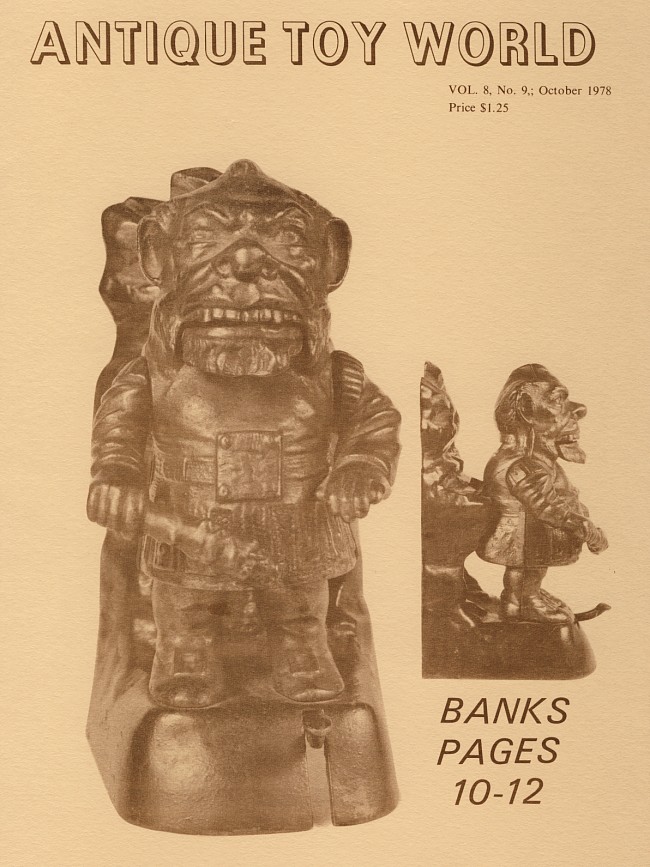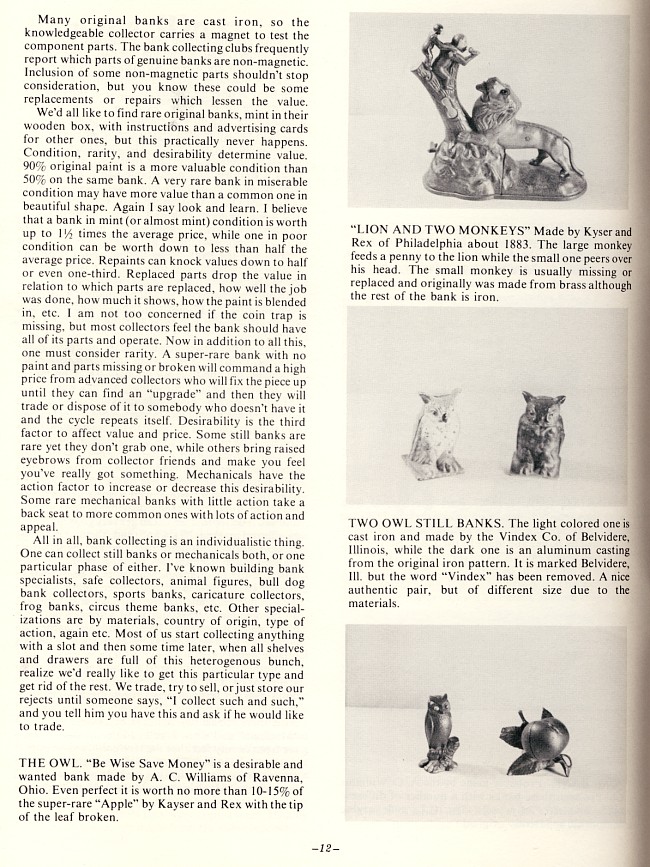|
ANTIQUE TOY WORLD
Vol. 8, No. 9, October 1978
Banking Ways and Daze
By Robert Bruce
There are many bank collectors and would-be bank collectors who
have doubts about values, authenticity, etc. How does paint condition,
rust, broken or missing parts affect values or prices of banks. I
confess that I have these doubts as does every collector I know,
including some of the well known collectors. These articles will try to
give guidelines which I find helpful and useful in solving some of these
problems, and illustrate some of the banks. Questions sent to the Editor
of this magazine will be forwarded and answered through these articles
wherever possible.
The first, and probably most important thing for you to do is study
the subject! Buy whatever books and catalogs that you can, visit your
library and read Mr. Griffith's articles on "Mechanical Banks," in the
last 25 years of "Hobbies." Join the "Mechanical Bank Club of America"
or the "Still Bank Collectors Club of America," go to museums,
commercial banks that have display collections, flea markets, antique
shows, and look and learn. Visit gift shops to feel and see what modern
bank reproductions are like. Try to visit collectors to see their
collections and, above all, keep an open mind about what you are told.
Bank collectors and clubs generally share all the information they have,
but sometimes you'll hear conflicting stories. Time will teach you which
is correct and which one is mistaken. If possible, buy major purchases
from reputable sellers who will guarantee the merchandise. You will
develop a feeling for the old banks and the repros will seem wrong to
you. Don't listen to Joe, your bowling buddy, or Frank, the beer can
collector, you keep meeting at the Flea Markets, who tell you it must be
really rare because they've never even seen one before. Don't listen to
the dealer or auctioneer who says it must be old because it came out of
the house of a little old lady who's had it for a long time! An old
friend of mine was given a "Paddy & His Pig" mechanical bank by his
grandsons twenty years ago, but they bought a "new" bank for grandpa,
not an antique. If this is ever sold from his estate, it won't be an
antique, even if he had it for many year. Look and handle old pieces and
learn.
Most of the reproductions on the market were not made to deceive
the unwary collector, but merely to be sold at a profit in a gift or
novelty shop. It's after this that through stupidity or cupidity of the
seller that the repros appear on the antique market as originals and
here is where we must beware. There is nothing wrong with buying a
modern or repro bank if we pay the modern or repro price for it. In
mechanicals there are two or three sets of repros clearly marked that
command higher prices than the usual repro, but far less than the
originals they were copied from. Usually the newer repros are made from
the older repros, not even from originals.
"PROFESSOR PUG FROG'S GREAT BICYCLE FEAT" Lots of action in this
bank. The frog on the bicycle makes a complete revolution throwing the
coin into the clown's basket and kicking mother goose's music as he
comes around. The action is so violent that I have never let it go but
have always held it back by hand. No wonder there are so many broken
mechanicals. Mother Goose's tongue is gone on this one—a common break.
"TEDDY AND THE BEAR BANK" A rather common mechanical, patented in
1907 by Bailey and manufactured by J. & E. Stevens Co. This particular
bank is an early one with "Patent applied for" on it.
"MAIN STREET STREETCARS" With and without people. Both gilded
finish. A pair of hard to find banks and a nice set.
BUSTER BROWN AND HIS DOG TIGE. A nice bank but not as valuable as
"Mary and Her Lamb." Buster made by the A. C. Williams Co. of Ravenna,
Ohio, but we don't know who manufactured the Mary Bank.
"MILKING COW BANK" Rare Mechanical with excellent action. Press the
daisy and the cow kicks the boy over spilling the bucket of milk.
Probably designed by Bailey and made by the J. & E. Stevens Co. of
Cromwell, Conn.
"CAR BANK" Probably made by the A. C. Williams Co. I've seen these
banks with a number of different kinds and sizes of wheels, Tin, C.I.,
and varying designs all apparently original.
Banks are made from many materials. Wood, tin, glass, pottery,
lead, aluminum, die cast, paper mache, and cast iron are a few of the
materials we find in banks. A plastic or cast aluminum reproduction of
an iron bank is obvious. However, most of the repros or recasts are in
cast iron, as many of the valuable originals are, so a little discussion
of foundry practices will help us. All molten metals shrink when
changing from liquid to solid state. The shrinkage of these metals
(Aluminum 3/ 16" per foot, cast iron 1/8" per foot) is uniform and
predictable and original banks were made from patterns which had these
shrinkage factors built in, so the finished parts would fit together and
work properly. Bob McCumber of Glastonbury, Connecticut, puts out books
with base tracings of original mechanical and still banks. To check for
repros, put the bank on its tracing and if it doesn't match, it's
probably not old. This isn't 100% sure, as the old banks were made at
more than one foundry and with different patterns. Sometimes changes
were made after the first few production runs showed problems, but in
general this is a good starting place for a new collector.
Many of our newer manufacturing processes make superior, uniform,
pieces when compared with older processes, but the foundry industry
today no longer can make smooth, thin castings, as they were in the
1870-1910 period. Economic pressures have all but eliminated hand work
and modern molding techniques and materials cannot compare to the old
hand molding process with extremely fine facing sand in the quality of
castings produced. The old banks with their carefully, exquisitely made
patterns, hand-molded with extremely fine sand next to the cast surface
and hand finished after casting, were almost works of art. In fact, many
collectors today feel they are examples of folk art. The repro loses
detail at every copying. Look at repros marked "Taiwan" and they are
almost unrecognizable. Modern castings are pebbly and grainy—rough
feeling and looking. Another indication is the fit of component parts.
The old banks usually have uniform spaces between parts with no gaps or
humps, while repros may have unsightly gaps or, in some place, be ground
to fit. Originals have lots of details on the surface—hair on animals,
feathers on birds, etc. Repros of the same bank show a lot less surface
detail. Another important clue to a bank's age is the paint and color on
it. Newer acrylics and synthetic lacquers don't age the same or have the
same colors as the original oil paints used. Facial tints are a
giveaway. I once drove almost two hundred miles on the trail of a
"Magician" and when I walked into the shop I could see from twenty feet
that the face color was wrong. It was a reproduction. Thank goodness
there were some other nice pieces (not banks), so the trip was not a
total loss, but the "Magician" stayed there. I still don't have it.
Many original banks are cast iron, so the knowledgeable collector
carries a magnet to test the component parts. The bank collecting clubs
frequently report which parts of genuine banks are non-magnetic.
Inclusion of some non-magnetic parts shouldn't stop consideration, but
you know these could be some replacements or repairs which lessen the
value.
We'd all like to find rare original banks, mint in their wooden
box, with instructions and advertising cards for other ones, but this
practically never happens. Condition, rarity, and desirability determine
value. 90% original paint is a more valuable condition than 50% on the
same bank. A very rare bank in miserable condition may have more value
than a common one in beautiful shape. Again I say look and learn. I
believe that a bank in mint (or almost mint) condition is worth up to
1-1/2 times the average price, while one in poor condition can be worth
down to less than half the average price. Repaints can knock values down
to half or even one-third. Replaced parts drop the value in relation to
which parts are replaced, how well the job was done, how much it shows,
how the paint is blended in, etc. I am not too concerned if the coin
trap is missing, but most collectors feel the bank should have all of
its parts and operate. Now in addition to all this, one must consider
rarity. A super-rare bank with no paint and parts missing or broken will
command a high price from advanced collectors who will fix the piece up
until they can find an "upgrade" and then they will trade or dispose of
it to somebody who doesn't have it and the cycle repeats itself.
Desirability is the third factor to affect value and price. Some still
banks are rare yet they don't grab one, while others bring raised
eyebrows from collector friends and make you feel you've really got
something. Mechanicals have the action factor to increase or decrease
this desirability. Some rare mechanical banks with little action take a
back seat to more common ones with lots of action and appeal.
All in all, bank collecting is an individualistic thing. One can
collect still banks or mechanicals both, or one particular phase of
either. I've known building bank specialists, safe collectors, animal
figures, bull dog bank collectors, sports banks, caricature collectors,
frog banks, circus theme banks, etc. Other specializations are by
materials, country of origin, type of action, again etc. Most of us
start collecting anything with a slot and then some time later, when all
shelves and drawers are full of this heterogenous bunch, realize we'd
really like to get this particular type and get rid of the rest. We
trade, try to sell, or just store our rejects until someone says, "I
collect such and such," and you tell him you have this and ask if he
would like to trade.
THE OWL. "Be Wise Save Money" is a desirable and wanted bank made
by A. C. Williams of Ravenna, Ohio. Even perfect it is worth no more
than 10-15% of the super-rare "Apple" by Kayser and Rex with the tip of
the leaf broken.
"LION AND TWO MONKEYS" Made by Kyser and Rex of Philadelphia about
1883. The large monkey feeds a penny to the lion while the small one
peers over his head. The small monkey is usually missing or replaced and
originally was made from brass although the rest of the bank is iron.
TWO OWL STILL BANKS. The light colored one is cast iron and made by
the Vindex Co. of Belvidere, Illinois, while the dark one is an aluminum
casting from the original iron pattern. It is marked Belvidere, Ill. but
the word "Vindex" has been removed. A nice authentic pair, but of
different size due to the materials.
|



